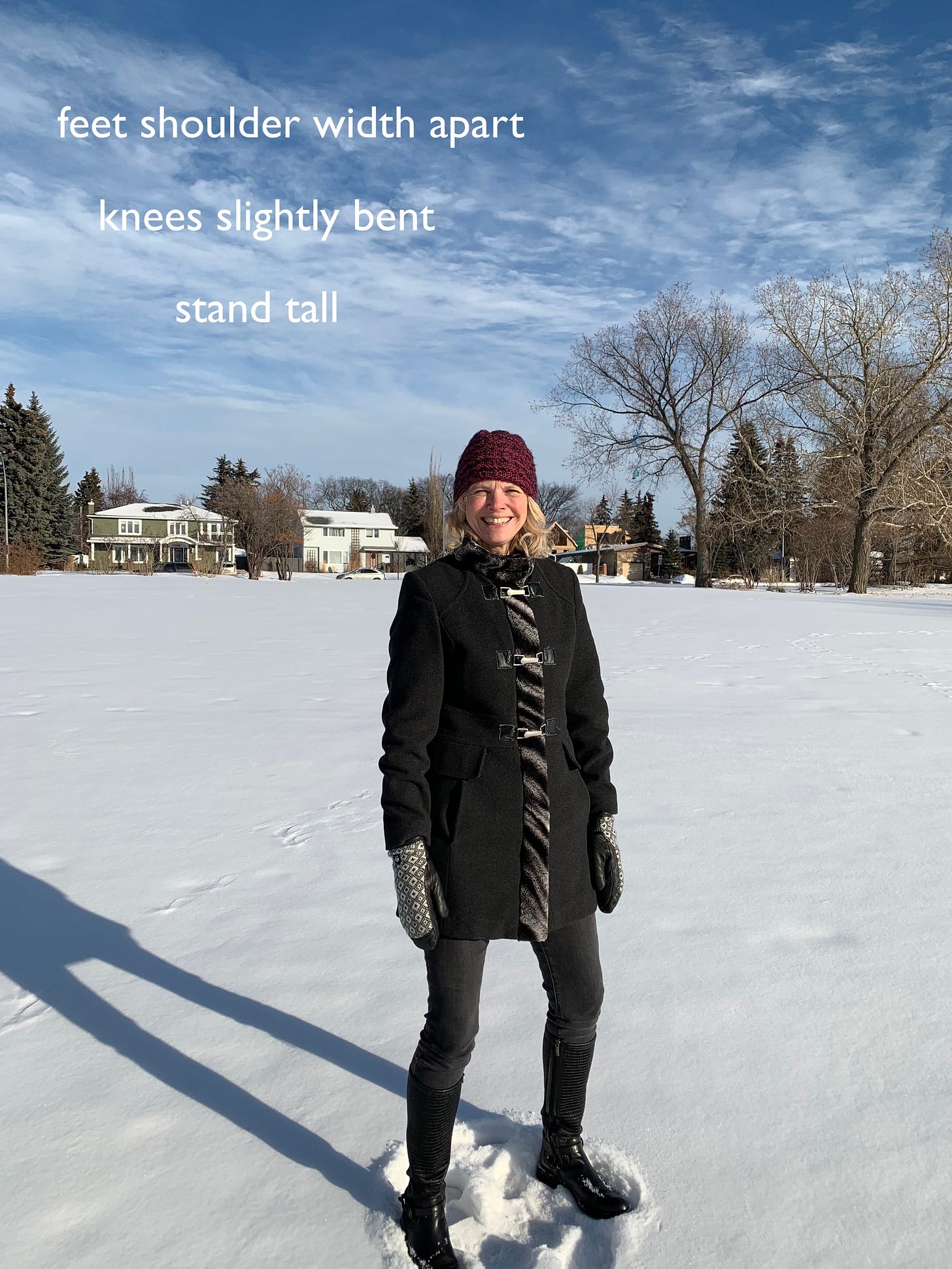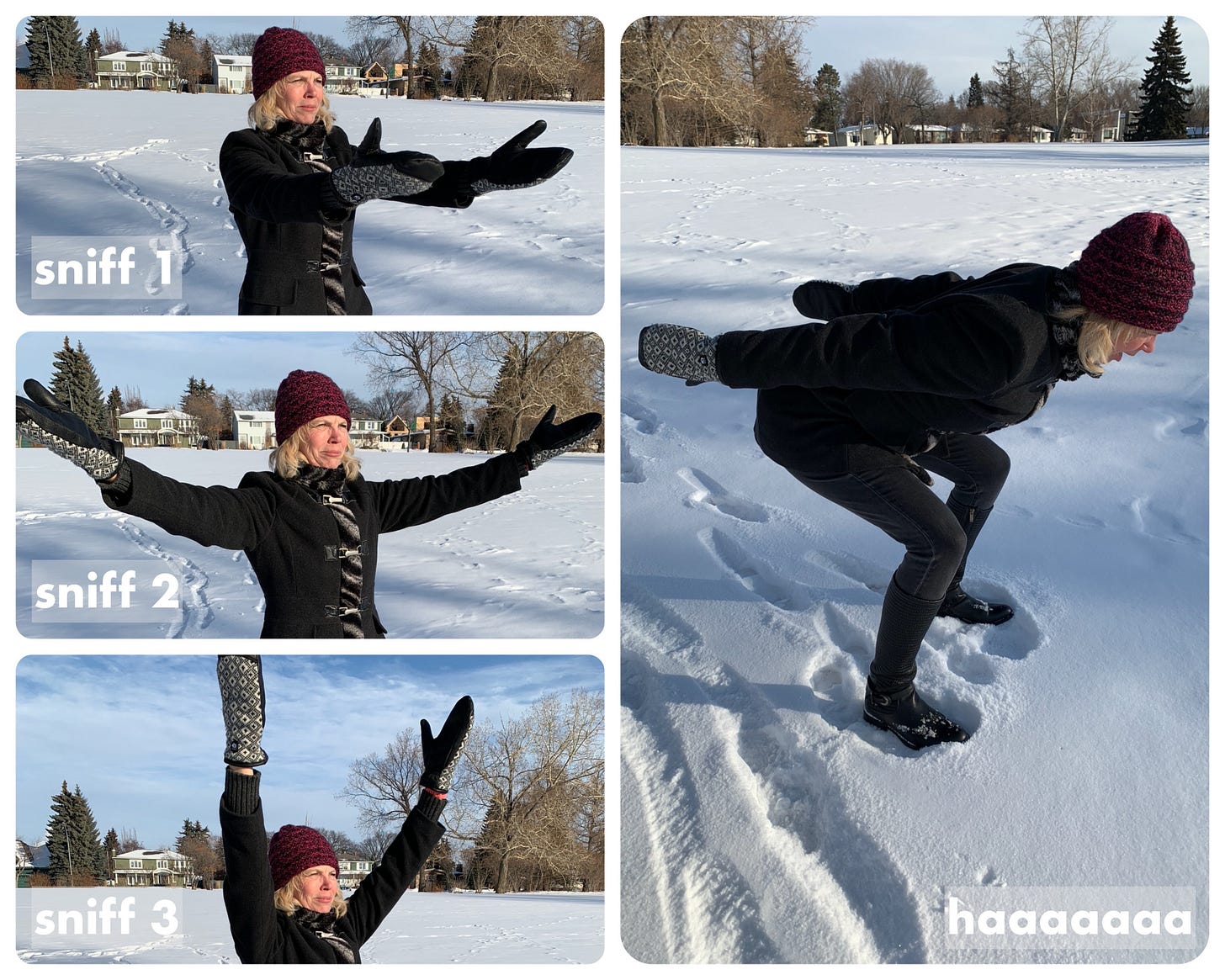Affairs of the Heart (3): Sniff Test
Is the respiratory diaphragm a good partner for the 'heart? Will it pass the sniff test? Will it return the heart's love with joy?
The sniff-stacking breath technique can be practiced in a variety of ways.
Overall it is used to build strength in the respiratory diaphragm’s downward movement and increase lung capacity. And interestingly, it also helps in keeping vocal folds open during the inhale.1
The Basic Practice - Breath of Joy
why?
The strong inhalations and synchronized arm movements awakens your whole body. The forceful exhalations lightly detoxifies the body and helps release pent-up tension.2
respect your limits, modify where needed
if pregnant definitely avoid, as this can bring on contractions
if you have high blood pressure, or suffer from migraines or glaucoma (eye issues), it is recommended to avoid the practice or consult with a doctor
stop the practice if you start to feel light-headed and breathe normally
pay attention to your exhales; make them slightly longer than the inhale
blow out the exhale with sound as this helps prevent unintended hyperventilation
best practice: always proceed slowly and mindfully
posture set-up
ideally, come to standing with feet shoulder-width apart
alternatively sitting upright in a chair without arm rests
toes pointing forward, feet parallel
knees slightly bent
breath of joy - sniff breath
inhale through the nose with three consecutive sharp sniff breaths as follows:
sniff, sniff, sniff
tip: although sharp, still keep sniffs somewhat relaxed, meaning keep shoulders down, neck relaxed, throat open
exhale is a forceful “haaa” through an open mouth
ensure “haaa” is coming from the respiratory & pelvic diaphragms and not from the throat
tip: add pelvic floor up and tummy in with the exhale
tip: keep throat relaxed
tip: use the “haaa” to release emotions, worries, agitations, etc.
breath of joy - breath with arm movement
1st sniff:
arms parallel to each other at shoulder level
palms facing the ceiling (or sky)
this arm movement helps fills lower abdomen
2nd sniff:
stretch arms out to the side like wings at shoulder level
this arm movement helps fill mid torso
3rd sniff:
swing arms parallel and over your head
palms facing each other
this arm movement helps fill upper chest
“haaa”:
bend knees more deeply
sink into a standing squat
swing arms down and back like a diver
this arm movement expels all the air
return to standing start position with knees slightly bent:
repeat up to nine times
to conclude
come to standing and notice what you notice
Yoga Practice - bunny breathing
This one is for kids young and old! Sniff like a bunny. It is called “Bunny Breathing” in Kids Yoga. It helps someone calm down quickly, as well as gives extra energy.
Basically it is the same breath pattern as “Breath of Joy” but without the arm actions.
sit up nice and tall
place hands on upper abdomen to feel the sniffs move the diaphragm
3 quick sniffs for the inhale
sniff, sniff, sniff
follow by a longer exhale; pick a sound:
“haaaa”
“sssss”
“shhh”
“whoo” with pursed lips like blowing out candles
repeat about five times
sit and notice how you feel
Explore the Movement - sniff breath while walking
When researching for this post, I found a booklet called “Vitalic Breathing” published in 1921. Try out some of Thomas Robert Gaines' ideas in general breathing, walking, stairs and running using his version of the sniff stacking technique.3
AVOID the below practices, if pregnant, have heart/blood pressure issues, and/or eye issues.
It uses the same sniff breath technique as “Breath of Joy” except everything is in and out through the nose. My tip: don’t worry about getting it all right. I often found myself using ‘haaa’ as my exhale. Experiment. Explore. Have fun!
Draw in air by two or three short, sharp, quick sniffs through the nose with mouth closed.
And expiring or expelling the air with one full, rapid, deliberate breath, also through the nose and with mouth closed.
General rule is expelling time is either equal to or about two-thirds the time of the two to three inspiring sniffs.
Here are a few examples for walking, running and when winded:
S = quick sniff; E = rapid exhale
both inhale and exhale are through the nose
Slow Walk (SSSEEE): step 1 sniff, step 2 sniff, step 3 sniff, step 4 exhale, step 5 exhale, step 6 exhale, step 7 repeat cycle
Fast Walk (SSSEE): step 1 sniff, step 2 sniff, step 3 sniff, step 4 exhale, step 5 exhale, step 7 repeat cycle
Slow Running (SSEE): step 1 sniff, step 2 sniff, step 4 exhale, step 4 exhale, step 5 repeat cycle
Fast Running (SSE) : step 1 sniff, step 2 sniff, step 3 exhale, step 4 repeat cycle
If Winded (SE): stop and repeat about 12 breaths of sniff then exhale, sniff then exhale
My Caution: ENSURE the sniff and exhale are coming from the abdomen and NOT the chest. If coming from the chest, STOP immediately as this is hyperventilation.
the author, Thomas Robert Gaines, says this will banish shortness of breath
Everyday Living
And there is one more sniff breath practice! Dr. Ken Hansraj, a spinal surgeon, recommends deep belly breathing with a ‘gentle’ sniff technique. He shares that it is important to create a gentle movement of the spine to help massage the nerve roots. He recommends incorporating the breath throughout your day. The Deep Belly Breath 5 Step technique is as follows:4
5 consecutive gentle “sniffs” in through the nose
belly expands
chest is relaxed
pause
5 consecutive gentle “ha” sounds out through the mouth
belly falls down
chest and shoulders remain relaxed
pause
aim to repeat for at least 5 or more cycles
Discover Amazing
Yes the respiratory diaphragm passes the sniff test and does loves the heart back❤️.
Sniff your way to joy and extra energy!
Your diaphragms, heart and breath are amazing. You are amazing!
Namaste
(the Light in me honors the Light in you)
keep moving to keep healthy to keep smiling
Thanks to Stefan Ritter for taking photos and video with the iPhone. Thanks also to Stefan for the use of his beautiful bunny photo.
Discover amazing treasures in the Archive:
Thanks for reading Explore Movement & Discover Amazing YOU! If not already a subscriber, subscribe now for free to receive new posts and support my work.
Disclaimer: Be safe, know your limits and move wisely without causing harm to yourself. Information provided in this newsletter is for you to explore and discover how your body works. It is not to diagnose any medical condition. Please consult with a physician or physiotherapist if you have concerns.
The Vocal Folds are one of the three diaphragms touched upon in the “Affairs of the Heart” (2): Dance post. What can happen for some people is called Vocal Cord Dysfunction. Meaning, instead of being fully open during an inhale, they partially close up. Thus limiting the ability to fully inhale. The sniff-stacking breath technique is used to re-train the vocal folds to remain open more consistently both on the inhale and exhale. Below is a screen-shot of vocal cords (normal vs dysfunction) taken from a slide presentation by Dr. Mary Noseworthy MD.
Amy Weintraub, Senior Kripalu teacher, Breath of Joy article Yoga International Winter 2010-11
Thomas Robert Gaines, Vitalic Breathing, (can be found online - book instantly downloads)
page 27 is a description on how to practice Vitalic Breathing.
page 46 how to use the breath with regular walking
pages 74 and 75 are tables on how to adapt the breath for different walking and running speeds
Dr. Ken Hansraj, YouTube Deep Belly Breath 5 Step Technique, and Sounds True Podcast at around minute 32. Dr. Hansraj also recommends getting up and moving 2 to 5 minutes every hour.







